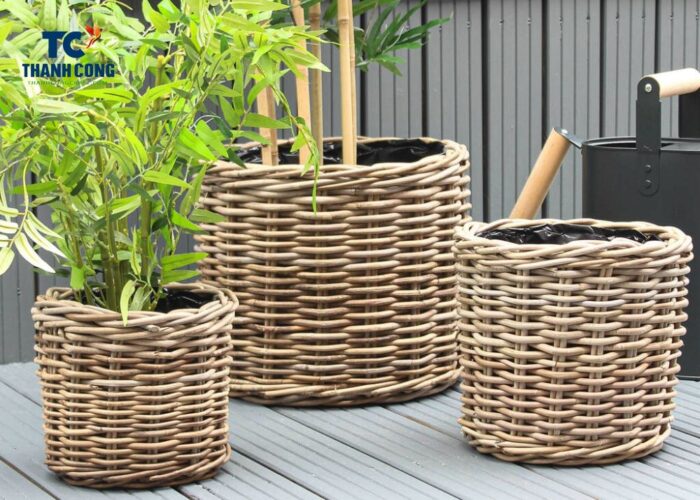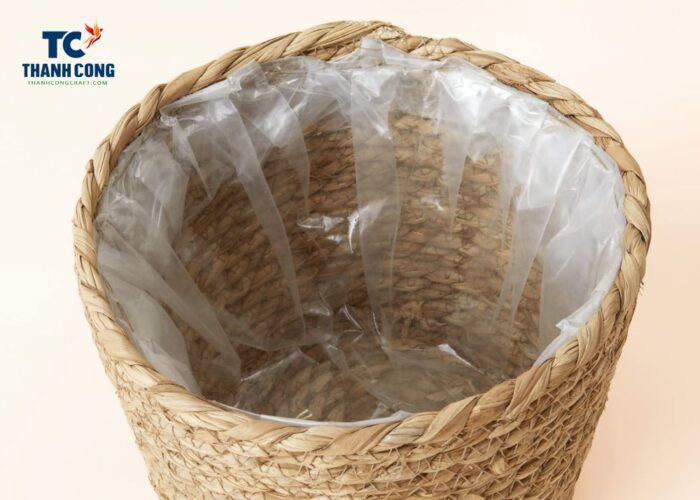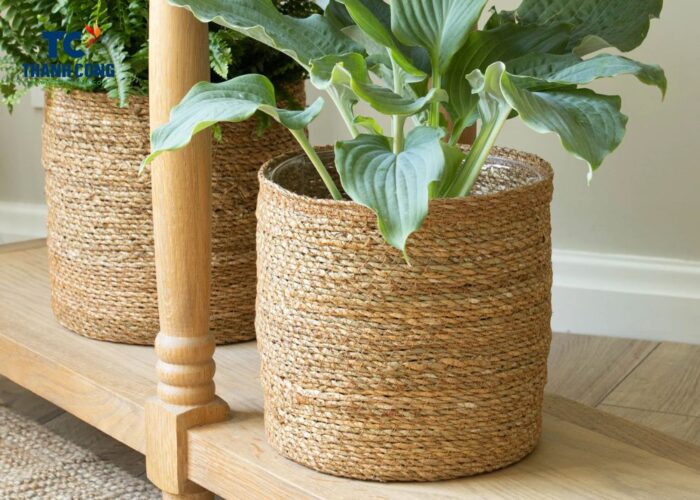Wicker baskets are a great choice for those who want to grow plants indoors or outdoors. They not only look beautiful, but also have many benefits for the plants. In this article, we will guide you how to use wicker baskets as plant pots, as well as some tips and notes to care for plants in wicker baskets.
Contents
1. Can you use a wicker basket as a planter?
Wicker baskets are a popular choice for decorating homes and gardens, but can you use them as planters?
The answer is yes, but with some precautions. Wicker baskets are made of natural materials that can rot or mold when exposed to moisture, so you need to protect them from water damage.
Here are some tips on how to use wicker baskets as planters:
- Choose baskets for plants that have a tight weave and a sturdy structure. Avoid baskets that have loose or frayed strands, as they can break easily or trap soil and water.
- Line the inside of the wicker basket with a plastic bag or a waterproof liner. This will prevent the basket from getting wet and rotting. Cut some holes in the bottom of the liner for drainage.

- Fill the basket with potting soil and your choice of plants. Make sure the plants are suitable for the size and shape of the basket, and that they have similar watering and light requirements.
- Place the basket in a location that gets enough sunlight and air circulation, but not too much wind or rain. You can also hang the basket from a hook or a bracket, but make sure it is secure and stable.
- Water the plants regularly, but avoid overwatering. Check the soil moisture by inserting your finger into the soil. If it feels dry, water the plants until the water drains out of the holes in the liner. If it feels moist, wait until it dries out a bit before watering again.
Enjoy your wicker basket planter! You can change the plants according to the seasons or your preferences, but remember to always use a liner and drain the excess water.
2. How to use wicker baskets as planters?
Wicker baskets are an excellent choice for infusing rustic charm into your garden or balcony, doubling as convenient planters for flowers, herbs, succulents, and more. Here are some tips on effectively using wicker baskets as planters:
- Add a Liner: Opt for a wicker basket with a liner or add one using materials like plastic, fabric, burlap, or coconut fiber. Liners help retain moisture and prevent soil spillage.
- Ensure Proper Drainage: Drill holes in the basket’s bottom for effective drainage, preventing waterlogging and root rot. Enhance drainage by adding gravel or pebbles to the basket’s base.
- Choose Appropriate Potting Mix: Fill the basket with potting mix suitable for your plants. You can use a general-purpose mix or create your own blend with compost, perlite, and vermiculite. Enhance the soil with fertilizer or organic matter for added richness.

- Mindful Planting: Plant your chosen flora in the basket, leaving space for air circulation and growth. Opt for plants with similar water and light needs or create a diverse basket with varied colors, textures, and heights.
- Watering Routine: Regularly water your plants, avoiding overwatering. Check soil moisture by inserting a finger; water when dry and allow drainage. Wait for the soil to slightly dry before the next watering if it feels moist.
- Strategic Placement: Position the basket in an area receiving sufficient sunlight for your plants. Adjust its location to follow the sun or shade as needed based on the season and weather.
- Pruning Maintenance: Keep your plants healthy and neat by pruning as necessary. Remove any dead, diseased, or damaged parts. Pinch off faded flowers to stimulate additional blooming and maintain the vibrancy of your wicker basket planter.
2.1 How to turn a wicker basket into a planter?
A wicker basket can be a great option for a planter, as it adds a rustic charm and allows for good drainage. However, you need to prepare the basket properly before planting, or else it may rot or leak.
Here are some steps to turn a wicker basket into a planter:
- Choose a basket that is sturdy and has no holes or gaps. You can use any shape or size, but make sure it can fit your plants and has enough depth for the roots.
- Line a wicker basket for planting with a plastic sheet or a garbage bag. Cut off any excess material and poke some holes at the bottom for drainage. This will prevent the soil from spilling out and protect the basket from moisture.

- Fill the basket with potting mix, leaving some space at the top. You can use any type of soil that suits your plants, but make sure it is well-draining and fertile.
- Plant flowers in a wicker basket, arranging them according to your preference. You can use flowers, herbs, succulents, or any other plants that can thrive in containers. Make sure to water them well after planting.
- Place the basket in a sunny spot and enjoy your new planter. You may need to water it more often than a regular pot, as the wicker can dry out quickly. You can also add some mulch or moss on top of the soil to retain moisture and add some texture.
To put a plant in a wicker basket, set the plant on top of the soil in the wicker basket. Ensure that the plant is centered and sits at the desired height. Add more potting soil around the sides of the plant’s pot to fill any gaps between the pot and the basket. Gently press the soil down to secure the plant in place.
3. FAQs
3.1 Can you plant directly into a wicker basket?
Yes, you can plant directly into the wicker basket. However, you should note that the wicker basket is not as waterproof as the usual pots. To avoid soil and water spilling out, you can place a liner such as nylon or non-woven fabric inside the basket before putting soil and plants.
This helps to retain soil and water, while protecting the wicker basket from damage due to moisture.
3.2 What do you line a basket with for plants?
Various materials are suitable for lining baskets, but selecting the right one depends on factors such as the basket’s size, shape, material, and the type of plants you intend to grow. Common lining materials include straw, non-woven fabric, plastic mesh, leaves, bark, moss, coconut fiber, canvas, or lining fabric.
When lining baskets, it’s advisable to create a layer approximately 2-3 cm thick, covering the entire interior of the basket. Additionally, leave a few small holes at the bottom to facilitate proper drainage and prevent waterlogging.
Once lined, proceed to fill the basket with soil and plant your chosen flora. Ensure the selected plants align with the specific light, humidity, and temperature conditions of the basket’s placement. By considering these factors during the lining and planting process, you set the stage for a successful and visually pleasing container garden.
3.3 Are wicker baskets ok outside?
Wicker baskets can be used outside or indoor plants, but their durability largely depends on the type of wicker and the weather conditions in your area. Natural wicker, typically made from materials like rattan, bamboo, or willow, is more susceptible to damage from exposure to moisture, sunlight, and extreme temperatures.
If you plan to use wicker baskets outdoors, it’s advisable to choose ones specifically designed for outdoor use, made from synthetic materials like resin or PVC that are more resistant to the elements.
Additionally, applying a protective sealant or outdoor varnish can help prolong the life of natural wicker baskets when used outside, but periodic maintenance may still be necessary to ensure their longevity.
4. Conclusion
In conclusion, embracing the versatility of wicker baskets as planters is a creative and practical way to enhance your green spaces. As demonstrated throughout this guide on how to use wicker baskets as planters, these baskets provide a charming and natural aesthetic while serving as functional vessels for your favorite plants.
If you have any further questions, don’t hesitate to send thanhcongcraft an email us at info@thanhcongcraft.com or message us at WhatsApp: +84967485411. Hope to serve you soon! Best regard!












